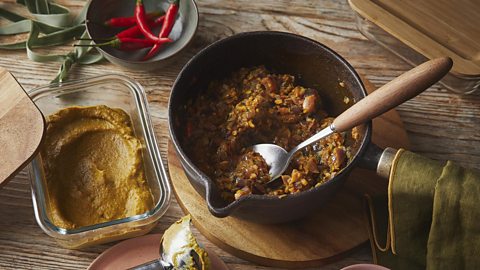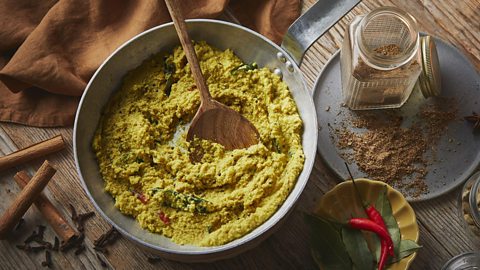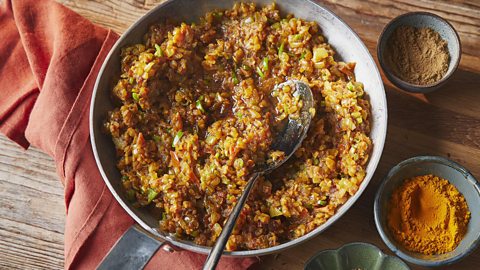'I use these recipes at least three times a week'
Romy Gill shares her tips and well-tested recipes for pastes and sauces she swears by to make the most delicious curries and more
By Romy Gill

The base of Indian curries varies significantly across the different states of India, all reflecting the rich diversity of regional cuisines. Growing up in West Bengal, I was eating dishes influenced by states all over India.
My father worked at the Burnpur steel plant, and as people moved to the region for work, the area quickly became a melting pot of different cultures and cuisines. As people arrived, they’d bring new spices and flavours with them, just as my parents had.
Friendships and communities were formed and different cooking styles were shared and eventually blended together. Every celebration, from births to religious festivals would involve food. I feel incredibly fortunate to have grown up in such a multicultural community.
When I moved to the UK in 1993, food once again became something over which friendships were formed. I initially moved to a tiny village on the west coast of Scotland, where I shared my love of Indian food with my new friends Helen and Angus. They in turn quickly taught me lots about British dishes, from bubble and squeak to the difference between shepherd’s pie and cottage pie.
I continued to blend cooking styles and ingredients and still do to this day. I’m always learning. And that’s how these curry bases have come about and become so significant in my life. Over the years I’ve found ingredients that are easy-to-source and that taste wonderful together. What’s more they’re really versatile – yes you can use them to create a delicious curry, but you could also include them in an omelette or scrambled eggs!
I use these bases at least three times a week and when friends and neighbours come over for food, they’re always requested. I’d suggest you make them in large batches, freeze them, and then use them whenever you want to bring the flavours of India to your kitchen.
Punjabi curry sauce base
This tomato-based sauce is something my parents introduced to me; they’d make it together. Sadly, my mum is no longer with us, but my dad still makes it.
First you add garlic to the pan then comes the ginger, red onions, bird’s eye chillies and tomatoes. You cook them on a high heat, so the oil expands rather than becoming absorbed into the onions.
Herbs and spices including fenugreek and coriander are added and you cover but stir occasionally. Once cooked you blend it into a fine paste before freezing or using.
What to add: This is perfect for any meat – especially chicken, lamb or fish. And you can add cream, yoghurt, or coconut milk depending on yout taste. Add a little water and simmer until the sauce is how you like it.
Alternatively, if you’re after a vegetarian dish, it goes well with chickpeas or kidney beans – in fact, any type of beans! Another option is to add potatoes (either white or sweet) to the sauce, that’s my daughters’ favourite. See the recipe for more details on how to turn this paste into a curry.
Punjabi curry sauce base
Add meat or vegetables to this base for a rich, tomatoey curry

Keralan curry paste
This played a significant role in my childhood as my friend Simi's mum Amma would make it for me whenever I visited their house. She would also send me back home with some so my parents could use it in their dishes too.
Coconut is the star of the show in this paste and while back in India, coconut flesh would be grated down and then put through a muslin cloth to remove extra moisture (the milk would be used for another dish), you can really simplify the process by simply soaking desiccated coconut in hot water for a short while.
This recipe uses no onions (so no time spent softening them). You simply blend the ingredients into a fine paste and add a couple of drops of water if it’s too thick. It’s quick to make and, if you prefer milder Indian food, this is a great paste to use because you don’t need to include chillies.
When using the paste with meat, Amma would also add her own blend of garam masala to the mix and I’ve included the recipe for this too. It uses ingredients including cardamom, star anise and cloves (for the full recipe click on the image below), so it has a real warmth to it. But if you’re serving it as part of a vegetarian dish you could simply add ground coriander to the paste instead.
Keralan curry paste and garam masala
This coconut-based paste goes with so many types of dishes and can be really creamy

What to add: Coconut is a very mild flavour and really suits all types of ingredients, however you could treat it like a korma and add cashews to it before adding the meat of your choice. See the Recipe Tips for details on quantities.
Whatever you make with it, if you want more tang, you could grate a shallot, onion or garlic into the paste. And when heating it up, you could add green chillies too.
Tarka base
Tarka is also known as ‘tempering’ and a method of heating the spices and other ingredients in hot oil and ghee. This helps to release their flavours and it forms the foundation of many Indian dishes.
This is a Punjabi-style of cooking, in that you cook the dal separately – with lentils, salt, turmeric and water in one pan and the tarka in another. Only once the dal is cooked and softened do you add the paste to it and then you cook it together for a few more minutes.
Tarka base
This tarka adds flavour to everything from dal to scrambled eggs

What to add: Lentils are an obvious and comforting choice to mix with the tarka, but the paste also goes really well with eggs – you could make a spicy omelette – whisking a few spoonfuls of the tarka into your egg mix prior to frying. Likewise, you could do the same with scrambled eggs.
Another option is paneer, which you could grate into the tarka before heating. Alternatively use it like a marinade, to coat meat before cooking.
The key with all three curry bases is to not be put off experimenting with them. Add ingredients or spices that you love into them and try serving them alongside different ingredients and dishes.
The joy of these bases – and cooking – is that you often find your new favourite meal by taking a few risks and being adventurous along the way.
Originally published October 2024